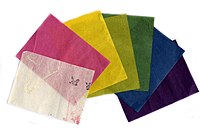Ise washi

Ise washi is a type of traditional Japanese paper that is made in a special way. It starts with the inner bark of the paper mulberry tree, which is peeled off and soaked in water to make it soft. Then, the bark is pounded with a wooden mallet to make the fibers separate. This is like smashing the bark to make tiny pieces.
After the fibers are separated, they are mixed with water and spread evenly on a bamboo screen. Think of this screen like a big flat table made out of bamboo sticks. The papermaker uses a tool called a suketa to gently move the fibers around on the screen. The water drains away through the cracks in the bamboo, but the fibers stay behind and stick together. This forms a thin layer of paper.
Next, the paper is carefully taken off the bamboo screen and pressed between a series of wooden boards. This helps to squeeze out any remaining water and makes the paper even thinner and smoother. It's like when you press a flower in a heavy book to make it flat and dry.
After pressing, the paper is hung up to dry. It is usually left to dry outside in the fresh air and sunshine. Sometimes, the paper is dried on wooden boards called "drying boards". This allows the paper to dry flat and become even smoother.
Once the paper is completely dry, it is finished and ready to be used. Ise washi can be used for many things like writing, drawing, and even making beautiful artworks. It is very strong and can last for a long time because the fibers are well-made and tightly packed together.
Ise washi is special because it has been made in the same way for hundreds of years. The process is not easy, and it requires a lot of skill and patience to make the paper just right. People in Japan love using Ise washi because it is a traditional art form that showcases the beauty of their culture.
After the fibers are separated, they are mixed with water and spread evenly on a bamboo screen. Think of this screen like a big flat table made out of bamboo sticks. The papermaker uses a tool called a suketa to gently move the fibers around on the screen. The water drains away through the cracks in the bamboo, but the fibers stay behind and stick together. This forms a thin layer of paper.
Next, the paper is carefully taken off the bamboo screen and pressed between a series of wooden boards. This helps to squeeze out any remaining water and makes the paper even thinner and smoother. It's like when you press a flower in a heavy book to make it flat and dry.
After pressing, the paper is hung up to dry. It is usually left to dry outside in the fresh air and sunshine. Sometimes, the paper is dried on wooden boards called "drying boards". This allows the paper to dry flat and become even smoother.
Once the paper is completely dry, it is finished and ready to be used. Ise washi can be used for many things like writing, drawing, and even making beautiful artworks. It is very strong and can last for a long time because the fibers are well-made and tightly packed together.
Ise washi is special because it has been made in the same way for hundreds of years. The process is not easy, and it requires a lot of skill and patience to make the paper just right. People in Japan love using Ise washi because it is a traditional art form that showcases the beauty of their culture.
Related topics others have asked about:
